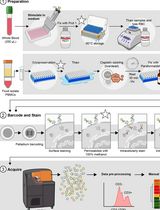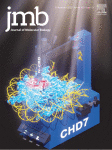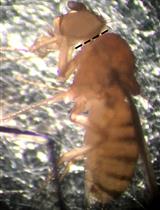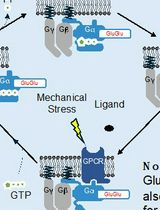- EN - English
- CN - 中文
In vivo Characterization of Endogenous Protein Interactomes in Drosophila Larval Brain, Using a CRISPR/Cas9-based Strategy and BioID-based Proximity Labeling
利用CRISPR/Cas9 策略和基于BioID的邻近标记研究果蝇幼虫大脑内源性蛋白相互作用体的体内特性
发布: 2022年07月05日第12卷第13期 DOI: 10.21769/BioProtoc.4458 浏览次数: 4303
评审: David PaulRajesh RanjanSonya NassariAnonymous reviewer(s)

相关实验方案

用于比较人冷冻保存 PBMC 与全血中 JAK/STAT 信号通路的双磷酸化 CyTOF 流程
Ilyssa E. Ramos [...] James M. Cherry
2025年11月20日 2086 阅读
Abstract
Understanding protein-protein interactions (PPIs) and interactome networks is essential to reveal molecular mechanisms mediating various cellular processes. The most common method to study PPIs in vivo is affinity purification combined with mass spectrometry (AP–MS). Although AP–MS is a powerful method, loss of weak and transient interactions is still a major limitation. Proximity labeling (PL) techniques have been developed as alternatives to overcome these limitations. Proximity-dependent biotin identification (BioID) is one such widely used PL method. The first-generation BioID enzyme BirA*, a promiscuous bacterial biotin ligase, has been effectively used in cultured mammalian cells; however, relatively slow enzyme kinetics make it less effective for temporal analysis of protein interactions. In addition, BirA* exhibits reduced activity at temperatures below 37°C, further restricting its use in intact organisms cultured at lower optimal growth temperatures (e.g., Drosophila melanogaster). TurboID, miniTurbo, and BirA*-G3 are next generation BirA* variants with improved catalytic activity, allowing investigators to use this powerful tool in model systems such as flies. Here, we describe a detailed experimental workflow to efficiently identify the proximal proteome (proximitome) of a protein of interest (POI) in the Drosophila brain using CRISPR/Cas9-induced homology-directed repair (HDR) strategies to endogenously tag the POI with next generation BioID enzymes.
Keywords: BirA (BirA)Background
There are numerous approaches to identify protein-protein interactions (PPI)s, including yeast two-hybrid (Y2H), affinity purification combined with mass spectrometry (AP–MS), and proximity labeling (PL). Conventional methods such as Y2H and AP–MS are commonly used to identify interacting protein partners. However, these methods rely on high affinity and stable protein interactions and are less effective at identifying weakly and/or transiently interacting partners (Rees et al., 2015). In the past decade, PL methods coupled to MS have been developed as a powerful complementary approach and utilized to reveal PPI networks in spatial and temporal detail (Bosch et al., 2021; Qin et al., 2021). In general, PL enzymes are fused to a protein of interest (POI), where they convert a small molecule substrate to a reactive intermediate that, upon release, covalently labels proteins in close proximity (Xu et al., 2021).
Proximity-dependent biotin identification (BioID) is one of the commonly employed PL techniques based on BirA, a 35 kDa biotin protein ligase from Escherichia coli. Wild-type BirA converts biotin to reactive biotinoyl-5’-AMP in the presence of ATP and labels exposed lysine residues of substrates with biotin. BioID-based PL utilizes a mutant form of BirA (BirA[R118G], referred to as BirA*), which has lower affinity for reactive biotinoyl-5’-AMP compared to wild-type BirA and thereby prematurely releases reactive biotin resulting in promiscuous biotinylation of neighboring proteins (Roux et al., 2012; Sears et al., 2019). Biotinylated proteins are then pulled down with affinity reagents and analyzed by MS to map the protein interactome. BirA* enzymes derived from Aquifex aeolicus (BioID2) and Bacillus subtilis (BASU) as well as engineered forms of E. coli BirA* (miniTurbo, TurboID, and BirA*G3) offer the advantage of increased enzymatic activity and/or smaller size, and have been successfully used for PL-strategies (Kim et al., 2016; Branon et al., 2018; Ramanathan et al., 2018; Samavarchi-Tehrani et al., 2020; Droujinine et al., 2021).
One important consideration when using PL enzymes is the expression level, as it has been shown to have significant effects on the obtained interactome maps, especially in systems where expression cannot be tightly controlled, like endogenous protein expression (Shiraiwa et al., 2020; Xu et al., 2021). Overexpression alters the spatio-temporal occurrence of a POI and might interfere with its localization and/or physiological function, eventually resulting in biotin-labeling artifacts. As an alternative, CRISPR/Cas9-mediated HDR strategies allow modifying endogenous gene loci to express in-frame chimeras of the POI and a next generation PL enzyme under the control of endogenous regulatory elements.
Here, we provide a detailed protocol to generate endogenous BioID fusions in Drosophila and perform in vivo PL in larval brains of these flies, followed by liquid chromatography–tandem mass spectrometry cubed (LC–MS3) analysis.
Materials and Reagents
1.5 mL microcentrifuge tube (Biotix, catalog number: MTL-0150-BC)
2.0 mL microcentrifuge tube (Biotix, catalog number: MT-0200-BC)
Acetonitrile hypergrade (Merck, catalog number: 75-05-08)
Apple juice (any brand)
Bacto-agar (Sigma, catalog number: A5306)
cOmpleteTM, Mini, EDTA-free protease inhibitor cocktail (Roche, catalog number: 11836170001)
D-(+)-Biotin, 98+% (Alfa Aesar, catalog number: A14207)
Dithiothreitol (DTT) (Roche, catalog number: 11583786001)
Drosophila sorting brush (any brand)
DynabeadsTM MyOneTM Streptavidin C1 (Thermo Fisher Scientific, catalog number: 65002)
Embryo collection cages (Genesee Scientific, catalog number: 59-100)
Ethanol 96% vol (VWR Chemicals, catalog number: 83804.360)
Fly food (Nutri-Fly Bloomington formula (BF), Genesee Scientific, catalog number: 66-113)
Fly food vials (VWR, catalog number: 734-2264)
Formic acid (VWR Chemicals, HiPerSolv CHROMANORM for LC–MS, catalog number: 84865.290)
Goat anti-biotin HRP (Cell Signaling Technology, catalog number: 7075)
Methyl methanethiosulfonate (Sigma-Aldrich, catalog number: 64306-10mL)
Methyl-4-hydroxybenzoate (Sigma-Aldrich, catalog number: H5501-500G)
Petri dishes (VWR, catalog number: 390-1373)
Phosphate-buffered saline (PBS) tablets (Medicago, catalog number: 09-9400-100)
phosSTOPTM phosphatase inhibitor tablet (Roche, catalog number: 4906837001)
PierceTM High pH Reversed-Phase Peptide Fractionation Kit (Pierce, catalog number: 84868)
PierceTM BCA Protein Assay Kit (Thermo Fisher Scientific, catalog number: 23225)
Rabbit 11H10 anti-α-tubulin (Cell Signaling Technology, catalog number: 2125)
rLys-C (Promega, catalog number: V1671)
Sucrose (Sigma, catalog number: S0389)
Tissue grinding pestles (Kisker Biotech, catalog number: 033522)
TMTproTM 16plex Label Reagent Set (Thermo Fisher Scientific, catalog number: A44521)
Triethylammonium bicarbonate (Honeywell Fluka, catalog number: 17902-100mL)
Trifluoroacetic acid (Sigma-Aldrich, catalog number: 299537-50g)
Tris (2-carboxyethyl) phosphine (Thermo Scientific, catalog number: 77720)
Tris-Cl pH 7.4 (Alfa Aesar, catalog number: J60202.K2)
PierceTM Trypsin protease (Pierce, catalog number: 90057)
Yeast paste (baker’s yeast in tab water) (Kisker Biotech, catalog number: 789093)
Apple-juice agar plates (see Recipes)
25% ethanolic Methyl-4-hydroxybenzoate (see Recipes)
4× Laemmli Buffer (see Recipes)
RIPA buffer (see Recipes)
Wash buffer 1 (see Recipes)
Wash buffer 2 (see Recipes)
Wash buffer 3 (see Recipes)
Equipment
Acclaim TM PepMap TM 100 C18 HPLC Column (Thermo Fisher Scientific, catalog number: 164199)
Easy-nLC TM 1200 (Thermo Fisher Scientific, catalog number: LC140)
Heating block (Grant, model: QBD2)
Incubator (Termaks, catalog number: TS 8056)
In-house packed analytical column (ESI Source Solutions, catalog number: PTC3-75-50-SP)
Magnetic stand (Thermo Fisher Scientific, model: DynaMag-2)
Microcentrifuge (Thermo Fisher Scientific, model: Fresco 21)
Microcentrifuge (VWR, model: CT15RE)
Orbitrap FusionTM LumosTM TribridTM mass spectrometer interfaced with an Easy-nLC1200 liquid chromatography system (Thermo Fisher Scientific, catalog number: IQLAAEGAAPFADBMBHQ)
Reprosil-Pur C18 (Dr. Maisch, catalog number: R13.AQ.0001)
Rotator (Thermo Fisher Scientific, Labquake, catalog number: 13-687-12Q)
Ultrapure water system (Elga LabWater, Purelab)
Vacuum centrifuge (Genevac, miVac, catalog number: DUC-23050-B00)
Software
Mascot (Matrix Science, Version 2.5.1)
Proteome DiscovererTM (Thermo Fisher Scientific, Version 2.4, catalog number: OPTON-30945)
Procedure
文章信息
版权信息
© 2022 The Authors; exclusive licensee Bio-protocol LLC.
如何引用
Uçkun, E., Wolfstetter, G., Fuchs, J. and Palmer, R. H. (2022). In vivo Characterization of Endogenous Protein Interactomes in Drosophila Larval Brain, Using a CRISPR/Cas9-based Strategy and BioID-based Proximity Labeling. Bio-protocol 12(13): e4458. DOI: 10.21769/BioProtoc.4458.
分类
发育生物学 > 细胞信号传导
生物工程 > 生物医学工程
细胞生物学 > 细胞信号传导 > 胞内信号传导
您对这篇实验方法有问题吗?
在此处发布您的问题,我们将邀请本文作者来回答。同时,我们会将您的问题发布到Bio-protocol Exchange,以便寻求社区成员的帮助。
Share
Bluesky
X
Copy link











